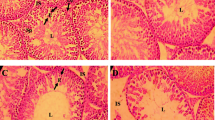Abstract
The reproductive system is one of the most sensitive systems of the organism that reacts on environmental pollution. Former experiments (1,2) led to the conclusion that independent of nature ecologically unfavourable factors induce common disturbances in the normal functioning of the female reproductive system. Dose dependent changes in circadian rhythm of gonadoliberin (GnRH) secretion up to its full suppression under the influence of xenobiotics were found in organum vasculosum of lamina terminalis (OVLT) located in preoptic area (PA) of hypothalamus. Such pronounced alterations were not observed in medial eminence (ME) of hypothalamus which is also responsible for GnRH secretion. It is known that gonadoliberin (GnRH) arises mainly from the anterior hypothalamus and PA neurons and is tranferred to the pituitary through ME. However, this is not the only way in which it is transported. Our investigation has shown that OVLT also plays a significant role in this process being under control of catecholamines and serotonine, and some other inhibitory neurotransmitters (GABA, taurine, opioid peptides etc.) (Fig. 1). From the facts reviewed here it seems likely that normal circadian rhythm of GnRH secretion exists due to decrease of the inhibitory action of definite axone endings in OVLT.
Access this chapter
Tax calculation will be finalised at checkout
Purchases are for personal use only
Preview
Unable to display preview. Download preview PDF.
Similar content being viewed by others
References
Stepanov, M.G., Arutjunyan, A.V., 1995, Voprosy meditsinskoi khimii, 41: 53–56 (Russian).
Stepanov, M.G., Arutjyan, A.V., 1995, J. Neurochem. 65: S44.
Bakalkin, G.Ya., Yarygin, K.N., Isachenkov, V.A., 1976, Problemy endokrinologii 22: 68–72 (Russian).
Abramova, V.V., Fedotov, V.P., 1982, Problemy endokrinologii 28: 68–72 (Russian).
Ristola, M., Repo, H., 1990, J. Biolum. Chemilum. 68: 727–732.
Strechler, B.L., Soup, C.S., 1953, Arch. Biochem. Biophys. 47: 1–15.
Stalnaya, I.A., 1977, Sovremennye metody Biokhimii, Moscow, P.P. 63–66 (Russian).
Chio, K.S., Tappel, A.L., 1969, Biochemistry 8: 2821–2827.
Author information
Authors and Affiliations
Editor information
Editors and Affiliations
Rights and permissions
Copyright information
© 1997 Springer Science+Business Media New York
About this chapter
Cite this chapter
Arutjunyan, A.V., Stepanov, M.G., Korenevsky, A.V., Prokopenko, V.M., Oparina, T.I. (1997). The Disturbances of the Hypothalamic Circadian Rhythm Regulation in Female Rats Under the Influence of Xenobiotics. In: Teelken, A., Korf, J. (eds) Neurochemistry. Springer, Boston, MA. https://doi.org/10.1007/978-1-4615-5405-9_89
Download citation
DOI: https://doi.org/10.1007/978-1-4615-5405-9_89
Publisher Name: Springer, Boston, MA
Print ISBN: 978-1-4613-7468-8
Online ISBN: 978-1-4615-5405-9
eBook Packages: Springer Book Archive




